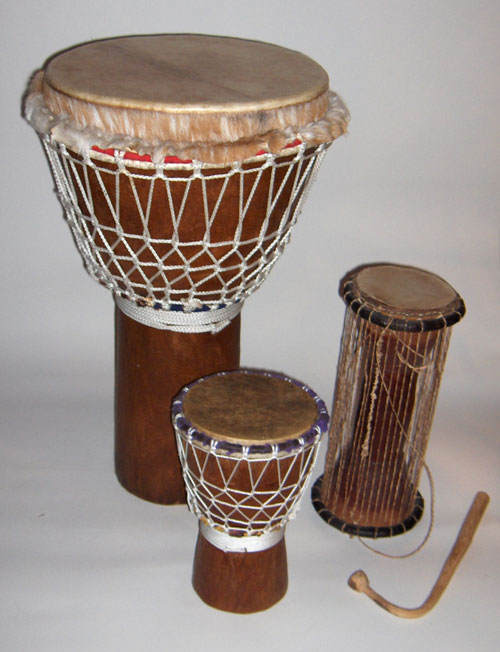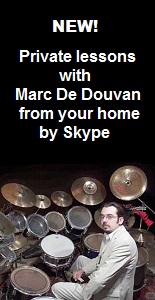
 : : : Percussions : : Africa: the Mandingo percussions
: : : Percussions : : Africa: the Mandingo percussions
The Malinke or Mandingo culture, comes from one of the most ancient peoples of the world (there are very ancient prehistoric traces). This is why, in addition to the fact that it has developed a very strong oral tradition until today, it is probably quite difficult to date and locate the emergence of musics that now extend on regions and ethnic groups of Mali, Guinea, Burkina Faso, Ivory Coast, Ghana, Sierra Leone, Senegal, etc.

The recurrence of certain rhythms (such as the basic rhythm of the djembe, whatever polyrhythms) and the very rudimentary technique of instruments manufacturing (hollowed tree trunk and roughly cut by hand for the shells, strings and shaved goat skin , wrought iron for bells and hoops) suggests that its bases have little changed from immemorial time (perhaps thousands years?). This reflects a culture where the notion of perpetuation plays a predominant role, unlike many societies that have chosen for progress and constant cultural change ("fashion"), as in Europe or Asia, for example.
In addition to giving us an image almost intact of forms of the past long been forgotten in our society, they tell us, when we examine closely, to relativize the notion of progress, so their wealth and particularism are great compared to our European musical knowledge, and so their approach as well gestual as intellectual answer to different requirements but which have nothing to envy to the European canons, which yet claim from an evolution and accumulation of secular knowledge and talents. Indeed, the european percussive practice almost exclusively using sticks, has long forgotten how to use different hand positions to get an almost infinite range of timbres and notes from a single drum. In addition, with the quasi-exclusive development of the polyphonic and harmonic complexity, European music has lost polyrhythmic complexity and sense of improvisation (that the United States uncovered with the jazz and blues of former slaves of African origin). Some musicians today are trying to find that lost wealth in the attempt to reconstruct an authentic practice of baroque and medieval European music (today it is already closer to an archaeological work than perpetuation work!).

This is what makes me think, personally, but this is only my practitioner intuition, that as in many traditional art forms, although a basic shape remains unchanged, develops in detail a real evolution and research, from the hard work of virtuosos specialized in their art and transmitting their findings to future generations.
To have analyzed and tried to recreate note for note in classic European solfege whole solos pieces of Mamady Keïta and percussion pieces in all styles, I found in Mamady the mark of the greatest which consists to present forms (even if not many) unheard and "un-viewed" (in written form), so we can say that they are their own and they have invented (which defines them as true artists, as creators, not simple reproducing "technicians").
It is also interesting to note that some rhythms are found again in percussive Cuban music (cascara, beguine, Nanigo, for example).
In his geographical, ethnological, historical and musical (with custom scores) book written in collaboration with the German music teacher Ushi Billmeier ("Mamady Keita, a life for the djembe," Arun, 1999) Mamady stress the importance of social context associated with different polyrhythms. We could associate this concern with a sense of "sacred" or a desire of memory of the origins of music in our country where music became an isolated domain which is sufficient to itself, where even foreign music should appear in the same context becomed normative, more than liberating.
For my part, I consider that it is good to seek to integrate and mix foreign musical forms and instruments without putting into "museums" and I prefer to simply note with regret that almost only for Mandingo people, the music is everywhere, even in the most mundane tasks of pounding millet or harvest, giving work with a will and justifying a participation of everyone. The practice of music and dance at the heart of the life of every citizen: large program, close to utopia for our "Spectacle societies"!

The popularity of a number of more and more young Europeans for the djembe evidenced to me both a desire for authenticity, ecology, refusal of excessive progress, a desire to become a player of art and not just a spectator, for fun and not for a salary, of a redevelopment of craft and a more physical and sensory involvement in a century which died of comfort and intellectualism.
Personally, this is probably these reasons that pushed me intuitively to buy my first percussion instrument, a djembe for children, at flea market, more than 15 years ago, and to play it first several yearsas self-taught, for the pleasure of discovery, physical and sensory confrontation with the "elements".
The attraction of the cultures of the north for African culture is now not only an alternative for me, it became the logical following, the missing and forgotten element for too long put aside, of the puzzle of the Western musical history.
The combination of the djembe and modern instruments becomes increasingly evident today and this is perhaps the solution to a "divorce" that lasted too long between north and south, and which will eventually destroy us all, if things continue in the direction of protectionism and overexploitation, guided by an arrogant egocentric view which demonstrated a thousand times its sterility and injustice.

Marc De Douvan, octobre 2005, translation in English: April 2013.
© 2005 Marc de Douvan Crédits Mentions légales
